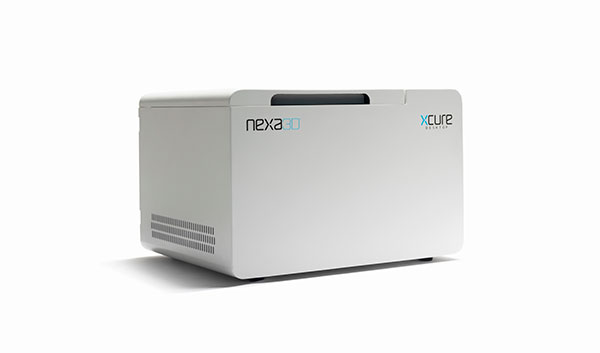Nexa3D Unveils Desktop Post-Processing and Three Resin Materials
xCURE Desktop System reduces curing time; new photopolymer resins expand applications in aerospace, automotive, and dental markets, company reports.

xCURE Desktop curing system reduces resin post processing by as much as 80%. Image courtesy of Business Wire.
Latest News
November 14, 2023
Nexa3D announced at Formnext, the introduction of a desktop cure system that reduces post-processing time, bringing post-processing to the desktop. The company also introduced three industrial resins, enabling new applications in automotive, aerospace, electronics and dental markets.
xCURE Desktop is a high-powered UV curing system that supports three wavelengths (365 nm, 385 nm and 405 nm), making it a solution for all resin printers. Housed in a rugged, anodized metal enclosure for durability, xCURE Desktop reduces cure times by up to 80% with most parts curing in under 10 minutes. This allows users to post-process parts much faster, and Nexa3D’s predefined curing workflows guarantee consistent mechanical properties and predictable part performance.
xPRO9400-FR, produced in partnership with BASF ForwardAM, sets a new standard in flame-retardant 3D printing materials. This rigid material with a UL 94 V-0 rating is halogen-free and features a high heat deflection temperature above 250°C. Ideal for production automotive and aerospace parts, electronics, custom jigs & fixtures and more, it stands out with its low viscosity, ease of handling and temperature resistance.
PRO9499 White from Henkel is a cost-effective modeling material that delivers feature resolution and accuracy. It maintains a matte white finish even after post-curing, for a wide variety of modeling applications.
Saremco Print CROWNTEC is a composite resin specially formulated for biocompatible permanent dental restorations. It offers a wide range of applications, including inlays, onlays, veneers, dentures and temporary bridges but is most often used for temporary and permanent crowns. With multiple shades and aesthetics, it ensures a match for any dental restoration.
Sources: Press materials received from the company and additional information gleaned from the company’s website.
Subscribe to our FREE magazine, FREE email newsletters or both!
Latest News
About the Author
DE’s editors contribute news and new product announcements to Digital Engineering.
Press releases may be sent to them via DE-Editors@digitaleng.news.






